great depression

 Sometimes, what seems like a necessary change, and what might have been done with good intentions, ends up being far more detrimental than helpful. In the United States, from 1879 to 1933 our monetary system was based on and utilized gold. The lone exception to that was the embargo on gold exports during World War I. With the gold standard, creditors had the right to demand payment in gold. It was a stable and tangible source of income and payment, and it ensured that the borrower actually had the funds to make the payment. The bank failures during the Great Depression of the 1930s frightened the public, causing them to begin hoarding gold, making the “payment in gold” policy untenable, furthering the panic. On June 5, 1933, Congress enacted a joint resolution nullifying the right of creditors to demand payment in gold, thereby taking the United States off the gold standard. That meant that our currency was no longer backed by gold. This may not have seemed like a bad solution at the time, but it certainly opened the door for a number of huge problems later.
Sometimes, what seems like a necessary change, and what might have been done with good intentions, ends up being far more detrimental than helpful. In the United States, from 1879 to 1933 our monetary system was based on and utilized gold. The lone exception to that was the embargo on gold exports during World War I. With the gold standard, creditors had the right to demand payment in gold. It was a stable and tangible source of income and payment, and it ensured that the borrower actually had the funds to make the payment. The bank failures during the Great Depression of the 1930s frightened the public, causing them to begin hoarding gold, making the “payment in gold” policy untenable, furthering the panic. On June 5, 1933, Congress enacted a joint resolution nullifying the right of creditors to demand payment in gold, thereby taking the United States off the gold standard. That meant that our currency was no longer backed by gold. This may not have seemed like a bad solution at the time, but it certainly opened the door for a number of huge problems later.
President Roosevelt had seen how this worked when Britain was facing similar pressures, and they decided to drop the gold standard in 1931. So, when the Great Depression hit, Roosevelt decided to implement it in the US. Soon after taking office in March 1933, President Roosevelt declared a nationwide bank moratorium in order to prevent a run on the banks by consumers lacking confidence in the economy. At the same time, he forbade banks from paying out gold or to exporting it. He based his decision on the Keynesian economic theory, which states that one of the best ways to fight off an economic downturn is to inflate the money supply. If the amount of gold held by the Federal Reserve is increased, it would in turn increase its power to inflate the money supply.
With that in mind, Roosevelt, on April 5, 1933, ordered all gold coins and gold certificates in denominations of more than $100 turned in for other money. The order required all persons to deliver all gold coin, gold bullion, and gold certificates owned by them to the Federal Reserve by May 1, 1933. In exchange, they were to be given $20.67 per ounce. I’m sure it seemed like a good deal, so the people complied. By May 10, the government had taken in $300 million of gold coin and $470 million of gold certificates. Congress two months later, enacted a joint resolution repealing the gold clauses in many public and private obligations that required the debtor to repay the creditor in gold dollars of the same weight and fineness as those borrowed. To complete the inflation process, in 1934, the government price of gold was increased to $35 per ounce, effectively increasing the gold on the Federal Reserve’s balance sheets by 69 percent. This increase in assets allowed the Federal Reserve to further inflate the money supply. So, with a stroke of the pen, the Federal Reserve, and thereby the government increased their wealth by 69%…overnight.
The $35 per ounce value of gold held August 15, 1971, when President Richard Nixon announced that the United States would no longer convert dollars to gold at a fixed value, thus completely abandoning the gold standard. Now I’m not an economist, but if I understand this correctly, it was at that point that the United States, as well as many other nations, began using what is known as “Fiat Money.” Fiat money is “a type of currency that is not backed by a precious metal, such as gold or silver. Fiat money is an intrinsically valueless object or record that is accepted widely as a means of payment. Accordingly, the value of fiat money is greater than the value of its metal or paper content.” It is designated by the issuing government to be legal 
 tender and it was authorized by government regulations, which means that the government could decide what its value would be. That would render the money to be worthless. Not that it changed much in the amounts of Fiat money in use at the time, but in 1974, President Gerald Ford signed legislation that permitted Americans to own gold bullion again.
tender and it was authorized by government regulations, which means that the government could decide what its value would be. That would render the money to be worthless. Not that it changed much in the amounts of Fiat money in use at the time, but in 1974, President Gerald Ford signed legislation that permitted Americans to own gold bullion again.

 Being the oldest child isn’t always the easiest job. My Aunt Evelyn Hushman, my mom’s sister, was born on November 9, 1928…shortly before Black Monday and the beginning of the Great Depression. These were not easy times, and everyone had to pitch in. That isn’t always easy for anyone, but for the oldest child, it means helping to raise all the children born after you are, and when the family has 9 children, that’s eight children that you get to help raise. Granted, Aunt Evelyn was a little young to help much with her sisters, Virginia and Deloris, but she helped a lot more when it came to Larry, Collene (my mom), Wayne, Bonnie, Dixie, and Sandy…who was just three years older than her first niece, Sheila “Susie” Young. At that point, the cycle came back around, and some of the younger children got to help raise their nieces and nephews.
Being the oldest child isn’t always the easiest job. My Aunt Evelyn Hushman, my mom’s sister, was born on November 9, 1928…shortly before Black Monday and the beginning of the Great Depression. These were not easy times, and everyone had to pitch in. That isn’t always easy for anyone, but for the oldest child, it means helping to raise all the children born after you are, and when the family has 9 children, that’s eight children that you get to help raise. Granted, Aunt Evelyn was a little young to help much with her sisters, Virginia and Deloris, but she helped a lot more when it came to Larry, Collene (my mom), Wayne, Bonnie, Dixie, and Sandy…who was just three years older than her first niece, Sheila “Susie” Young. At that point, the cycle came back around, and some of the younger children got to help raise their nieces and nephews.
Aunt Evelyn loved getting together with friends, and even her siblings. She and Uncle George often double dated with my parents, and they later bowled together for years. Aunt Evelyn was a very social person, and loved gatherings. I remember the whole Hushman family coming to celebrate my mom’s birthday, which was on New Year’s Day, hence the New Year’s Eve party. We always had such a great time when the Hushman family joined in the parties, and I really miss those days very much. Because it was Mom’s birthday party, all the kids were welcome, and sometimes I wonder if our parents were half crazy having at least ten kids in the house at one time, and mind you, it was too cold to play outside, because it was after all, the middle of winter. Still, a great time was had by all.


My parents, Aunt Evelyn, and Uncle George also bowled together every Thursday night. They had a great time. I don’t remember what kind of averages they all had but I think they were pretty good bowlers. They loved spending time together, and bowling was a great way to do that. They were good friends all of their lives, and I know my mom couldn’t stand the idea of living without her big sister. Mom loved her so very much. I’m thankful they are together again in Heaven. Today would have been Aunt Evelyn’s 93rd birthday. Happy birthday in Heaven Aunt Evelyn. We love and miss you very much.
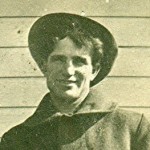
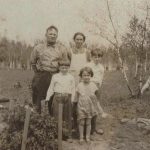 I never had the opportunity to get to know my Grandpa Allen Luther Spencer, because he passed away before my parents were married, and 4½ years before I was born. Life was not always easy for my grandfather. His first marriage ended in divorce, following the death of his daughter, Dorothy, which was quickly followed by the birth of his son, Norman. The loss of a child can be so devastating, that many people never recover, and many marriages fail. It was a dark time for him, until he met my grandmother.
I never had the opportunity to get to know my Grandpa Allen Luther Spencer, because he passed away before my parents were married, and 4½ years before I was born. Life was not always easy for my grandfather. His first marriage ended in divorce, following the death of his daughter, Dorothy, which was quickly followed by the birth of his son, Norman. The loss of a child can be so devastating, that many people never recover, and many marriages fail. It was a dark time for him, until he met my grandmother.
After their marriage and four more children, Laura in 1912, Bill in 1922, Allen (my dad) in 1924, and Ruth in 1925, it looked like his life was on the right track again. Of course, like many other people, this good period was followed by the Great Depression. Thankfully, my grandfather was a carpenter (mostly for the Great Northern Railway), and as near as I can tell, had a job throughout the Great Depression. Still, times were tough, and I’m sure the wages were not what a family of six really needed to live. Most people struggled during the Great Depression.
My grandfather was a product of his circumstances, and the times he lived in, and the two things together created a stressful life for him and his second family. Much more was expected of the two older children, and feelings were raw at times. The younger two children really never remember his being so hard on them. Grandpa had specific ideas of things the children should learn and do. All of the children learned to play the violin and some learned the guitar. My Aunt Laura never really liked learning to play the violin, but the rest of the children did…or at least they did later. Grandpa Spencer may not have been an easy teacher, or maybe it’s just hard to learn from your dad.
No matter what kind of a man my grandfather was, and whether circumstances led to his troubles, his children loved him very much. Like any family, kids and parents “lock horns” sometimes. That doesn’t mean you don’t love them. When my grandfather was dying, my dad drove from Casper, Wyoming to Superior, Wisconsin, 980 
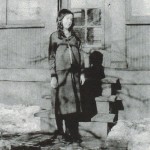 miles, in 17 hours. That might not seem like a big deal these days, but cars didn’t do what they can do now, and speeds were different then too. Needless to say, my dad made it home to see his dad before he passed away, and he was always thankful that he made the trip, and always thankful that he saw his dad one more time. I only wish I could have met him and gotten to know him too. I feel like I missed out, on my grandfather and my Grandma Spencer, who passed away when I was 2½ months old. Happy birthday in Heaven Grandpa Spencer. I look forward to meeting you someday soon.
miles, in 17 hours. That might not seem like a big deal these days, but cars didn’t do what they can do now, and speeds were different then too. Needless to say, my dad made it home to see his dad before he passed away, and he was always thankful that he made the trip, and always thankful that he saw his dad one more time. I only wish I could have met him and gotten to know him too. I feel like I missed out, on my grandfather and my Grandma Spencer, who passed away when I was 2½ months old. Happy birthday in Heaven Grandpa Spencer. I look forward to meeting you someday soon.

 My Uncle Larry was born during the years of the Great Depression, in an era of big families. He was the 4th child and first son of my grandparents, George and Hattie Byer. While times were tough, the one thing that George and Hattie had plenty of was love. The family was rich in that. My mother, Collene Spencer, followed Uncle Larry in quick succession, arriving when he was just 20 months old. Following Mom, Uncle Wayne arrived two years later. Their childhood would be spent as close friends and allies, along with the associated sibling arguments too, I’m sure. While I’m not sure how the boys felt about Mom tagging along in things, they didn’t really complain too much, and defended their sister when needed. For her part, Mom considered these brothers, the only ones she had, to be…maybe her charges too somehow. She might very well be prone to protecting them, whether they needed it or not, even against their mother…to her detriment sometimes, because it earned her the same punishment that Grandma Byer was dishing out to her sons. Still, my mom looked up to and loved her brothers. I suppose that to a degree, being the girl between the brothers made her a bit of a tomboy, but it also shaped her into the wonderful woman who became my mom.
My Uncle Larry was born during the years of the Great Depression, in an era of big families. He was the 4th child and first son of my grandparents, George and Hattie Byer. While times were tough, the one thing that George and Hattie had plenty of was love. The family was rich in that. My mother, Collene Spencer, followed Uncle Larry in quick succession, arriving when he was just 20 months old. Following Mom, Uncle Wayne arrived two years later. Their childhood would be spent as close friends and allies, along with the associated sibling arguments too, I’m sure. While I’m not sure how the boys felt about Mom tagging along in things, they didn’t really complain too much, and defended their sister when needed. For her part, Mom considered these brothers, the only ones she had, to be…maybe her charges too somehow. She might very well be prone to protecting them, whether they needed it or not, even against their mother…to her detriment sometimes, because it earned her the same punishment that Grandma Byer was dishing out to her sons. Still, my mom looked up to and loved her brothers. I suppose that to a degree, being the girl between the brothers made her a bit of a tomboy, but it also shaped her into the wonderful woman who became my mom.
Uncle Larry was a determined man, who wanted something better for his family. I believe that land ownership was a part of that desire. I remember wondering as a kid, why he and my Aunt Jeanette chose to live in the country. The rest of the family at that time, were city dwellers (though Casper wasn’t a large city) and it always seemed strange to me that they lived in the country. Lots of land, however, gave them the ability to have a big place to entertain, and outbuildings to pursue any other activities they might be interested in, such as ceramics. They proudly hosted ceramics sessions with any of the family who wanted to join in. Grandma and Grandpa Byer were some of those who loved going out to get their “Crafty Side” on.
All of my grandparents kids lived most of their lives in Wyoming, most of them in Casper, so when Uncle Larry took a transfer to Louisiana with Texaco, I remember being quite shocked. I’m not sure why I should have been, because my own mother had lived for 5 years in Superior, Wisconsin, where my older sister, Cheryl and I were both born. Still, at the time, I felt kind of shocked. The refinery where Uncle Larry worked, here in Casper, closed, and he wasn’t old enough to retire, so he could take the transfer or take a layoff. The choice was simple really. They mover to Louisiana and lived their until his retirement before returning to live the rest of his life in 
 Casper, where both of their children, Larry and Tina both live too. I remember being quite happy when they moved back here. I felt like having the family back together again. My husband, Bob and I loved running into them on occasion, often at a home improvement store, where we were both looking for some new item we needed for our houses. When he passed away, I felt very sad that those impromptu meeting would now be over. Uncle Larry passed away on December 22, 2011, and I still miss him very much. Today would nave been Uncle Larry’s 86th birthday. Happy birthday in Heaven, Uncle Larry. We love and miss you very much.
Casper, where both of their children, Larry and Tina both live too. I remember being quite happy when they moved back here. I felt like having the family back together again. My husband, Bob and I loved running into them on occasion, often at a home improvement store, where we were both looking for some new item we needed for our houses. When he passed away, I felt very sad that those impromptu meeting would now be over. Uncle Larry passed away on December 22, 2011, and I still miss him very much. Today would nave been Uncle Larry’s 86th birthday. Happy birthday in Heaven, Uncle Larry. We love and miss you very much.
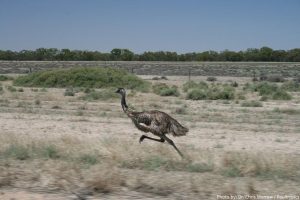 These days, it seems we are all aware of what an emu is, probably due to the Liberty Mutual commercials that are out there, but in 1932 Australia, these were a nuisance bird. They were everywhere and they were not popular. In fact, they were running amok in the Campion district of Western Australia, and the public was very concerned. They had made several attempts to curb the growth of the emu population, including the Australian soldiers being armed with Lewis guns…leading the media to adopt the name “Emu War” when referring to the incident. While a number of the birds were killed, the emu population persisted and continued to cause crop destruction.
These days, it seems we are all aware of what an emu is, probably due to the Liberty Mutual commercials that are out there, but in 1932 Australia, these were a nuisance bird. They were everywhere and they were not popular. In fact, they were running amok in the Campion district of Western Australia, and the public was very concerned. They had made several attempts to curb the growth of the emu population, including the Australian soldiers being armed with Lewis guns…leading the media to adopt the name “Emu War” when referring to the incident. While a number of the birds were killed, the emu population persisted and continued to cause crop destruction.
After World War I ended, the Australian government gave land to large numbers of ex-soldiers from Australia and the UK. The purpose of the gift was to take up farming within Western Australia, often in areas that had been counterproductive. When the Great Depression hit in 1929, these farmers were encouraged to increase their wheat crops. The government promised assistance in the form of subsidies, but later failed to deliver. In spite of the recommendations and the promised subsidies, wheat prices continued to fall, and by October 1932 matters were becoming critical, with the farmers preparing to harvest the season’s crops and threatening to refuse to deliver the wheat.
To make matters, the area was hit with the arrival of as many as 20,000 emus. This is apparently an annual event as the emus regularly migrate after their breeding season, heading to the coast from the inland regions. With the cleared land and additional water supplies being made available for livestock by the Western Australian farmers, the emus decided that the farmlands were a good, and closer habitat, and they began to foray into farm territory, especially in the marginal farming land around Chandler and Walgoolan. The emus began to eat and spoil the crops. In addition, they left large gaps in fences where rabbits could enter and cause further destruction.
When the farmers relayed their concerns about the birds ravaging their crops, and a group of the ex-soldiers were sent to meet with the Minister of Defense, Sir George Pearce. Something had to be done. Having served in World War I, the soldiers-turned-settlers were well aware of the effectiveness of machine guns, and they requested their deployment to fight this new enemy. The minister readily agreed, although with conditions attached: the guns were to be used by military personnel, troop transport was to be financed by the Western Australian government, and the farmers would provide food, accommodation, and payment for the ammunition. The farmers agreed and Pearce also supported the deployment on the grounds that the birds would make good target practice, while some in the government viewed the operation as a way of being seen to be helping the Western Australian farmers, as a way of staving off the secession movement that was brewing.
Sir George Pearce, who was later referred to in Parliament, as the “Minister of the Emu War” by Senator James Dunn, ordered the army to selectively thin the nuisance emu population…by large numbers. The “war” was scheduled to begin in October 1932, under the command of Major G P W Meredith of the Seventh Heavy Battery of the Royal Australian Artillery. Meredith was supposed to use troops armed with two Lewis guns and 10,000 rounds of ammunition, but the operation was delayed by a period of rainfall that caused the emus to scatter over a wider area. The rain finally stopped by November 2, 1932, and the troops were quickly deployed with orders to assist the farmers and, according to a newspaper account, to collect 100 emu skins so that their feathers could be used to make hats for light horsemen. On November 2nd, the men travelled to Campion, where some 50 emus were sighted. Unfortunately, when they got there, the birds were out of range of the guns. The local settlers attempted to herd the emus into an ambush, but the birds split into small groups and ran so that they were difficult to target. Nevertheless, while the first attack from the machine guns was ineffective due to the distance from the targets, a second round of gunfire was able to kill “a number” of birds. Later the same day, a small flock was encountered, and “perhaps a dozen” birds were killed.
The next significant event was on November 4th, when Meredith established an ambush near a local dam. More than 1,000 emus were spotted heading towards their position. This time the gunners waited until the birds were in close proximity before opening fire. The gun jammed after only twelve birds were killed and the rest scattered before any more could be shot. No more birds were sighted that day, so the decision was made to move further south, where the birds were “reported to be fairly tame.” The group had only limited success in spite of Meredith’s efforts. As the pursuit continued, it became apparent that “each pack seemed to have its own leader now…a big black-plumed bird which stands fully six feet high and keeps watch while his mates carry out their work of destruction and warns them of our approach.” In desperation, Meredith even went so far as to mount one of the guns on a truck. He was still ineffective, as the truck was unable to gain on the birds, and the ride was so rough that the gunner was unable to fire any shots, even if they had been able to get close. By November 8th, six days after the first attack, 2,500 rounds of ammunition had been fired. The number of birds killed is uncertain. One account estimates that it was 50 birds, but other accounts range from 200 to 500, the latter figure being provided by the settlers. Meredith’s official reported that there were no casualties among the men.
Summarizing the operation, ornithologist Dominic Serventy commented, “The machine-gunners’ dreams of point blank fire into serried masses of Emus were soon dissipated. The Emu command had evidently ordered guerrilla tactics, and its unwieldy army soon split up into innumerable small units that made use of the military equipment uneconomic. A crestfallen field force therefore withdrew from the combat area after about a month. On 8 November, members in the Australian House of Representatives discussed the operation. Following the negative coverage of the events in the local media, that included claims that “only a few” emus had died, Pearce withdrew the military personnel and the guns on 8 November.”
After the “Emu War” was over, Meredith compared the emus to Zulus and commented on the striking maneuverability of the emus, even while badly wounded. After the withdrawal of the military, the emu attacks on crops continued. Farmers again asked for support, citing the hot weather and drought that brought emus invading farms in the thousands. James Mitchell, the Premier of Western Australia lent his strong support to renewal of the military assistance. At the same time, a report from the Base Commander was issued that indicated 300 emus had been killed in the initial operation.
The killing continued periodically, with similar results. The Emu was just too fast, too aware, or too “lucky,” to be caught or killed. By December 1932, word of the Emu War had spread, reaching the United Kingdom.  Conservationists protested the cull as “extermination of the rare emu”. Dominic Serventy and Hubert Whittell, the eminent Australian ornithologists, described the “war” as “an attempt at the mass destruction of the birds”. Throughout 1930 and onward, the farmers tried exclusion barrier fencing as a means of keeping emus out of agricultural areas (in addition to other vermin, such as dingoes and rabbits). In November 1950, Hugh Leslie raised the issues of emus in federal parliament and urged Army Minister Josiah Francis to release a quantity of .303 ammunition from the army for the use of farmers. The minister approved the release of 500,000 rounds of ammunition. The emu continues to thrive today.
Conservationists protested the cull as “extermination of the rare emu”. Dominic Serventy and Hubert Whittell, the eminent Australian ornithologists, described the “war” as “an attempt at the mass destruction of the birds”. Throughout 1930 and onward, the farmers tried exclusion barrier fencing as a means of keeping emus out of agricultural areas (in addition to other vermin, such as dingoes and rabbits). In November 1950, Hugh Leslie raised the issues of emus in federal parliament and urged Army Minister Josiah Francis to release a quantity of .303 ammunition from the army for the use of farmers. The minister approved the release of 500,000 rounds of ammunition. The emu continues to thrive today.
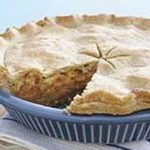
 No, I’m not talking of foods to eat when you are feeling depressed, although the Great Depression really did qualify as depressing. Nevertheless, as I was considering the days of the Great Depression, I wondered what foods the people had survived on, when money was scarce, and food was suddenly expensive…more so than these days, when you consider the lack of jobs and money. People were forced to re-evaluate their priorities and their food choices.
No, I’m not talking of foods to eat when you are feeling depressed, although the Great Depression really did qualify as depressing. Nevertheless, as I was considering the days of the Great Depression, I wondered what foods the people had survived on, when money was scarce, and food was suddenly expensive…more so than these days, when you consider the lack of jobs and money. People were forced to re-evaluate their priorities and their food choices.
It was at this point that foods like Bisquick, Good Humor ice cream bars, Kraft macaroni and cheese, Krispy Kreme doughnuts, Kool-Aid, Toll House chocolate chips, Ritz Crackers, and Spam appeared on the scene. They were inexpensive foods then, and they have never left us. To this day, some people call them “broke food.” In many ways, foods had to be more filling, more calorie laden, because you didn’t always get to eat as much as you wanted. That makes the calories important. Some foods became too pricey. Less expensive options on things became a must. Crisco was a less expensive option to butter, Oscar Meyer Wieners replaced more costly sausages, Maxwell House Sanka coffee was an option to whole bean coffees, Heinz Ketchup was used as the base for a simple tomato soup, Underwood Deviled Ham substituted fresh lunch meat, Carnation evaporated milk replaced fresh milk, Ground acorns became a substitute for coffee. People added chicory to extend the coffee supplies, while honey, molasses and corn sweeteners replaced sugar, because sugar was at a premium, and later on in World War II, it was rationed.
It wasn’t just the new foods that were strange, but rather what people made with some of them, that amazes me. Basically, foods changed from what we had known before, because fruits, vegetables, and meats weren’t as readily available. Things like meatless meatloaf and appleless apple pie appeared on the scene. Meatloaf became “anything” loaf…from meatless meatloaf made with everything from peanuts to raisins to liver loaf, families used their creativity and whatever was available to make this alternative to the weekly favorite. With a shortage of apples came the “mock apple pie” which substituted apples for crumbled crackers sprinkled with flavored syrup and cinnamon, all baked into a crust. The most famous of these recipes appeared on the back of the Ritz cracker box in 1934, the “Ritz mock apple pie” was an instant hit. Things like chipped beef on toast or waffles was also a staple, and one my mom, Collene Spencer picked up from her mom, Hattie Byer. Mom liked it so much that it was something we had from time to time. Basically, it used a little chipped beef and a lot of gravy. I can see how it would have been a staple in the Great Depression, because it was very filling. And of course, my personal favorite, and one I still love since my grandmother first made them for us, Potato Pancakes. Because of the wide availability and low cost of potatoes, Depression-era cooks used potatoes as substitutes in other dishes. Potato pancakes, made with grated potatoes cooked or fried in a pan, was a common dish at every meal. We loved them, and nobody made them like Grandma.
People foraged in their yards too. These days, many people drink Dandelion Tea or put Dandelion leaves in their salad. Of course, the dandelions we use today have to be carefully cultivated, because most of us try very hard to kill them when they spring up in our gardens. Weed killer would not make for “healthy” dandelions. Wild onions were also used, and were something I remember Mom telling us about. She loved them. Of course, people who knew about plants could forage for herbs that could be used for everything from seasoning to medicine. Most of us today don’t really know many of the herbs in the wild, although we might know them if we plant them from a seed.
Soups took on various new forms too. Mulligan Stew came about from those who were homeless, because it entailed putting in anything that was available. Some people actually went so far as to put lint in to make it more filling. “Tomato” soup even took on new forms, substituting Ketchup for tomato sauce. And they even managed to have dessert sometimes. Prune Pudding was founded during this time. Prunes were easy to store, 
 widely available, and much less expensive than other fruits, while providing needed nutrients to the Depression-era diet. The fruit is packed with fiber and supplies almost one-third of your daily needs for Vitamin K. And it already had sweetness, so there wasn’t much to do, but heat it. While some of the foods of the Great Depression era where designed to fill people up, some managed to be nutritious too. Either way, some of the foods developed back then are still with us today, and there are still a lot of us who have had some of the recipes that were developed in those days, by our grandparents.
widely available, and much less expensive than other fruits, while providing needed nutrients to the Depression-era diet. The fruit is packed with fiber and supplies almost one-third of your daily needs for Vitamin K. And it already had sweetness, so there wasn’t much to do, but heat it. While some of the foods of the Great Depression era where designed to fill people up, some managed to be nutritious too. Either way, some of the foods developed back then are still with us today, and there are still a lot of us who have had some of the recipes that were developed in those days, by our grandparents.
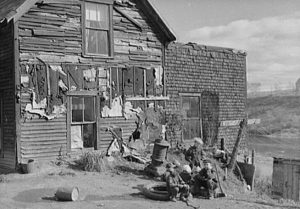 When the Great Depression hit, people in the upper-middle class, like doctors, lawyers, and other professionals, saw their incomes drop by 40%, but the middle class and low income Americans found themselves with nothing. They had no jobs and no money, and even if they did have those things, they couldn’t afford the things they needed. The prices for everything from food to clothing were much more than their meager income could buy much of. People began to move from place to place looking for a job…any job. The problem was that there were very few jobs, and lot of people standing in line to get them. The average American lived by the Depression-era motto: Use it up, wear it out, make do, or do without. People had to learn to be frugal. Clothes were patched when the started to wear out. People planted gardens and even kept little gardens in their kitchen. They stayed home, instead of evenings out. They were always in a private struggle to keep their cars or homes.
When the Great Depression hit, people in the upper-middle class, like doctors, lawyers, and other professionals, saw their incomes drop by 40%, but the middle class and low income Americans found themselves with nothing. They had no jobs and no money, and even if they did have those things, they couldn’t afford the things they needed. The prices for everything from food to clothing were much more than their meager income could buy much of. People began to move from place to place looking for a job…any job. The problem was that there were very few jobs, and lot of people standing in line to get them. The average American lived by the Depression-era motto: Use it up, wear it out, make do, or do without. People had to learn to be frugal. Clothes were patched when the started to wear out. People planted gardens and even kept little gardens in their kitchen. They stayed home, instead of evenings out. They were always in a private struggle to keep their cars or homes.
Paint was too expensive, so home fell into disrepair. As things got worse, things began to wear out, and people didn’t get rid of the junk. They simply put it out in the yard. I’m sure that they realized that every piece of junk had parts in it that could be used for repairs to something else. Everything could be reworked. They used the  backs of worn-out overall legs to make pants for little boys and overalls for babies. They didn’t have disposable diapers back then. They made diapers and underwear out of flour and sugar sacks. When the older kids outgrew their clothes, but they were too big for the younger kids, they made smaller clothes out of bigger hand-me-downs. If their shoes wore out before a year, the children went barefooted. Many people resorted to bartering…not only goods for goods, but work for work. They tried to make their homes and their lives pretty, even in depressing times. They used patterned chicken feed sacks to make curtains, aprons, and little girl’s dresses. Worn out socks were kept, so that they could patch another sock. Nothing was thrown away. They saved string that came loose from clothing and added it to a string ball for mending and sewing. Toilet paper was a luxury that many people couldn’t afford, so they used newspaper instead. They saved every scrap of material for making quilts. People learned not to waste anything.
backs of worn-out overall legs to make pants for little boys and overalls for babies. They didn’t have disposable diapers back then. They made diapers and underwear out of flour and sugar sacks. When the older kids outgrew their clothes, but they were too big for the younger kids, they made smaller clothes out of bigger hand-me-downs. If their shoes wore out before a year, the children went barefooted. Many people resorted to bartering…not only goods for goods, but work for work. They tried to make their homes and their lives pretty, even in depressing times. They used patterned chicken feed sacks to make curtains, aprons, and little girl’s dresses. Worn out socks were kept, so that they could patch another sock. Nothing was thrown away. They saved string that came loose from clothing and added it to a string ball for mending and sewing. Toilet paper was a luxury that many people couldn’t afford, so they used newspaper instead. They saved every scrap of material for making quilts. People learned not to waste anything.
Every part of the food was used. Potato peels were food, not waste. They made soup out of a few vegetables and a scrap of meat…for flavor only. They hunted for rabbits and fished to put what protein they could on the table. When there was nothing more to eat, they had lard sandwiches. I seriously doubt if many people went to  bed with a full stomach, but that didn’t mean that you turned away a stranger who was hungry. These people knew hw bad things were for them, and so they helped their neighbors. Nevertheless, during the Great Depression, suicide rates in the United States reached an all-time high, topping 22 suicides per 100,000 people. The living conditions were deplorable, and many people couldn’t take it. They felt that somehow they were at fault. still, for the majority of Americans, that didn’t mean that they gave up. Neighbor looked out for neighbor, and families came together to support each other, and while the effects of the Great Depression lasted for 12 years, this too passed, and the nation healed again.
bed with a full stomach, but that didn’t mean that you turned away a stranger who was hungry. These people knew hw bad things were for them, and so they helped their neighbors. Nevertheless, during the Great Depression, suicide rates in the United States reached an all-time high, topping 22 suicides per 100,000 people. The living conditions were deplorable, and many people couldn’t take it. They felt that somehow they were at fault. still, for the majority of Americans, that didn’t mean that they gave up. Neighbor looked out for neighbor, and families came together to support each other, and while the effects of the Great Depression lasted for 12 years, this too passed, and the nation healed again.
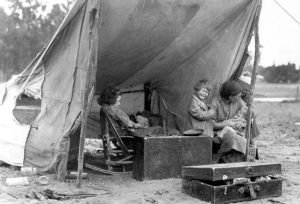
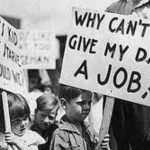 Following the Crash of 1929, which occurred on October 29, 1929, people quickly found that the jobs they thought were secure, were not only not secure, they were gone. That day became known as Black Tuesday. It was the day the stock market took a huge hit, as investors traded some 16 million shares on the New York Stock Exchange in a single day. Billions of dollars were lost, wiping out thousands of investors. The Great Depression followed the crash of 1929…banks failed, businesses closed, city streets were desolate, families lost their homes, and unemployment in rose to nearly 25%. The crash was the culmination of many years of economic instability. In the middle part of the United States, the depression occurred during the drought season. The farmers quickly lost their lands, because their crops died out, and many became migrant workers. They traveled around the country, hoping to find work for all members of the family in exchange for a meal or a place to sleep. Husbands and fathers traveled great distances from their homes in search of any work that they could find. There was no work…anywhere. Times were just about the worst they could possibly be.
Following the Crash of 1929, which occurred on October 29, 1929, people quickly found that the jobs they thought were secure, were not only not secure, they were gone. That day became known as Black Tuesday. It was the day the stock market took a huge hit, as investors traded some 16 million shares on the New York Stock Exchange in a single day. Billions of dollars were lost, wiping out thousands of investors. The Great Depression followed the crash of 1929…banks failed, businesses closed, city streets were desolate, families lost their homes, and unemployment in rose to nearly 25%. The crash was the culmination of many years of economic instability. In the middle part of the United States, the depression occurred during the drought season. The farmers quickly lost their lands, because their crops died out, and many became migrant workers. They traveled around the country, hoping to find work for all members of the family in exchange for a meal or a place to sleep. Husbands and fathers traveled great distances from their homes in search of any work that they could find. There was no work…anywhere. Times were just about the worst they could possibly be.
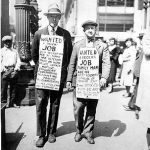
Architects, bankers, engineers and educators suddenly found themselves standing in long unemployment lines, competing for menial, basic jobs with pay that was barely enough to put food on their tables. Men who had defined themselves by taking care of their families, being the breadwinner, struggled with the emotional depression that came with the economic depression. As men traveled farther and farther away from home looking for jobs, they are forced to find lodging in public housing or shelters, waking up to begin job hunting again the next morning. Husbands and fathers who had previously earned enough money to feed and clothe their families were forced to stand in bread lines to receive free food so their families would not starve.
People became so desperate for work. As men went from town to town, they were met with billboard signs telling them to keep going, because there was no work in the town. Men with families even got their children involved, carrying signs asking why no one would hire their dad. Then men started wearing their resume on cardboard placards that they wore as they walked along. It seemed incredulous to the men who had been in higher paid jobs, that they could no longer find work…even with their qualifications. Signs like one saying, “I know 3 trades, I speak 3 languages, fought for 3 years, have 3 children and no work for 3 months. But I only 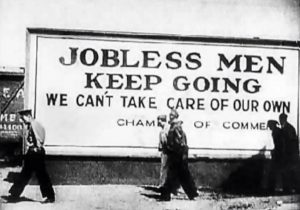
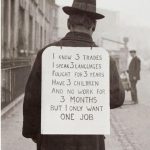 want one job,” appeared everywhere. Times couldn’t possibly get worse. While there’s no consensus about the exact end of the Great Depression among economic historians, the unemployment rate remained high for the rest of the 1930s, even as the banking crisis eased up. One major event, however, shifted the focus of the country away from the Great Depression. After the Japanese attack on Pearl Harbor on December 7, 1941, millions of men and women would join the work force as the US entered World War II.
want one job,” appeared everywhere. Times couldn’t possibly get worse. While there’s no consensus about the exact end of the Great Depression among economic historians, the unemployment rate remained high for the rest of the 1930s, even as the banking crisis eased up. One major event, however, shifted the focus of the country away from the Great Depression. After the Japanese attack on Pearl Harbor on December 7, 1941, millions of men and women would join the work force as the US entered World War II.

 In the late 19th century, America was growing. The pioneers headed west, because many couldn’t resist the lure of the tall grassy land in the midwestern and southern plains of the United States. They planned to settled there to farm. The next few decades were prosperous, but when the 1930s rolled in, so did strong winds, drought, and clouds of dust that plagued nearly 75 percent of the United States between 1931 and 1939. The Dust Bowl, as it was known, had arrived. The problem likely began in the early 1920s, when a post-World War I recession led farmers to try new mechanized farming techniques as a way to increase profits. Many bought plows and other farming equipment, and between 1925 and 1930 more than 5 million acres of previously unfarmed land was plowed. With the help of mechanized farming, farmers produced record crops during the 1931 season. However, overproduction of wheat coupled with the Great Depression led to severely reduced market prices. The wheat market was flooded, and people were too poor to buy. Farmers were unable to earn back their production costs and expanded their fields in an effort to turn a profit. The prairie was covered with wheat in place of the natural drought-resistant grasses, and to add to the problem, they left any unused fields bare. With the drought leaving much of the country severely dry, no natural grasses to hold the dirt in place, the higher than normal temperatures, and increasingly strong winds, the country was hit with what many called Black Blizzards, which were rolling dust storms driven by high winds.
In the late 19th century, America was growing. The pioneers headed west, because many couldn’t resist the lure of the tall grassy land in the midwestern and southern plains of the United States. They planned to settled there to farm. The next few decades were prosperous, but when the 1930s rolled in, so did strong winds, drought, and clouds of dust that plagued nearly 75 percent of the United States between 1931 and 1939. The Dust Bowl, as it was known, had arrived. The problem likely began in the early 1920s, when a post-World War I recession led farmers to try new mechanized farming techniques as a way to increase profits. Many bought plows and other farming equipment, and between 1925 and 1930 more than 5 million acres of previously unfarmed land was plowed. With the help of mechanized farming, farmers produced record crops during the 1931 season. However, overproduction of wheat coupled with the Great Depression led to severely reduced market prices. The wheat market was flooded, and people were too poor to buy. Farmers were unable to earn back their production costs and expanded their fields in an effort to turn a profit. The prairie was covered with wheat in place of the natural drought-resistant grasses, and to add to the problem, they left any unused fields bare. With the drought leaving much of the country severely dry, no natural grasses to hold the dirt in place, the higher than normal temperatures, and increasingly strong winds, the country was hit with what many called Black Blizzards, which were rolling dust storms driven by high winds.
Now, if you have ever been in a Haboob (Arabic meaning, blasting), which is a type of intense dust storm carried on a weather front, you have a pretty good idea of what the Dust Bowl was like, except that instead of lasting a few hours, the Dust Bowl storms continued to occur from 1931 to 1939. Now imagine 8 plus years of dust 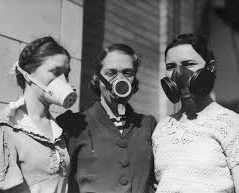 blowing everywhere!! It was in their hair, in their eyes, in their houses, and in the food. They couldn’t get away from it, and since 75 percent of the United States was in the grip of the Dust Bowl, moving didn’t help either…not to mention the fact that no one could afford to anyway. It was a disgusting situation, and it was about to get much worse. By 1932, 14 Black Blizzards were reported, and in just one year, the number increased to nearly 40. It seemed that no end was in sight, but still, the worst was yet to come.
blowing everywhere!! It was in their hair, in their eyes, in their houses, and in the food. They couldn’t get away from it, and since 75 percent of the United States was in the grip of the Dust Bowl, moving didn’t help either…not to mention the fact that no one could afford to anyway. It was a disgusting situation, and it was about to get much worse. By 1932, 14 Black Blizzards were reported, and in just one year, the number increased to nearly 40. It seemed that no end was in sight, but still, the worst was yet to come.
On the afternoon of April 14, 1935, the residents of the Plains States were forced to take cover as a Black Blizzard, blew through the region. The storm hit the Oklahoma Panhandle and Northwestern Oklahoma first, moving south for the remainder of the day. It hit Beaver around 4:00 pm, Boise City around 5:15 pm, and Amarillo, Texas, at 7:20 pm. The conditions were the most severe in the Oklahoma and Texas panhandles, but the storm’s effects were felt in other surrounding areas. The day would forever be labeled Black Sunday. It was one of the worst dust storms in American history and it caused immense economic and agricultural damage. It is estimated to have displaced 300 million tons of topsoil from the prairie area of the United States. The storm was so harsh because of the high winds that hit the area that day. The combination of drought, erosion, bare soil, and winds caused the dust to fly freely and at high speeds. The loose dust flying around was enough to inhale, and many people suffocated with the dust filling their lungs. The day was a black day for more reasons than one. It is hard to contemplate a dust storm that was so severe that people couldn’t breathe…to the point of death! Nevertheless, that was exactly what Black Sunday was like.
Following the horrible Black Blizzards of 1935, and the massive amount of damage caused by these storms, Congress passed the Soil Conservation Act, which established the Soil Conservation Service as a 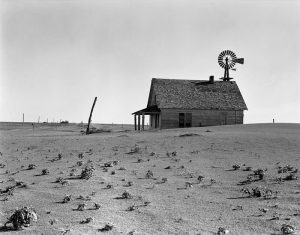
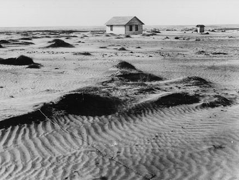 permanent agency of the USDA. The SCS was created in an attempt to provide guidance for land owners and land users to reduce soil erosion, improve forest and field land, and conserve and develop natural resources. It was the hope that the United States could prevent another Dust Bowl, and while small areas have a tendency to have dust storms, there has never been another era like the Dust Bowl era that the United States citizens suffered in the 1930s.
permanent agency of the USDA. The SCS was created in an attempt to provide guidance for land owners and land users to reduce soil erosion, improve forest and field land, and conserve and develop natural resources. It was the hope that the United States could prevent another Dust Bowl, and while small areas have a tendency to have dust storms, there has never been another era like the Dust Bowl era that the United States citizens suffered in the 1930s.
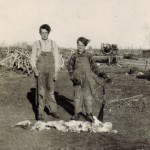 As young men, my dad and his brother, my Uncle Bill loved to do all the normal guy thins that most young men want to do, and hunting was right up there near the top, along with fishing, and pretty much anything that had to do with guns or dynamite, such as blowing a tree stump out of the ground, or sinking the front gate, and then fixing it before their mom found out. They were rough and rugged boys who, like most young men of those times, were growing up too fast. Times were hard, and families needed all the help they could get from all their children. Hunting was something families could do to supply food for their tables, and rabbits were always in abundance…then and now. Of course, for my dad and uncle, the guns were a cool as the hunting. They both loved guns and knew how to use them from the time they were little. Uncle Bill was hunting this particular day with a Mossberg, and my dad was using a 1906 Winchester.
As young men, my dad and his brother, my Uncle Bill loved to do all the normal guy thins that most young men want to do, and hunting was right up there near the top, along with fishing, and pretty much anything that had to do with guns or dynamite, such as blowing a tree stump out of the ground, or sinking the front gate, and then fixing it before their mom found out. They were rough and rugged boys who, like most young men of those times, were growing up too fast. Times were hard, and families needed all the help they could get from all their children. Hunting was something families could do to supply food for their tables, and rabbits were always in abundance…then and now. Of course, for my dad and uncle, the guns were a cool as the hunting. They both loved guns and knew how to use them from the time they were little. Uncle Bill was hunting this particular day with a Mossberg, and my dad was using a 1906 Winchester.
Like most boys, they had high hopes for their hunts. They were going to bag that big buck, or the most rabbits, or even bring in the most fish. I’m sure they competed against each other,  but I think that quite often, they pooled their resources and tried to beat the record they set the last time they went. Of course, nothing went to waste either, because that was not how things were done. The kills they made provided food for their family during those hard times of the great depression.
but I think that quite often, they pooled their resources and tried to beat the record they set the last time they went. Of course, nothing went to waste either, because that was not how things were done. The kills they made provided food for their family during those hard times of the great depression.
Though times were tough, I don’t really think my dad or his brother noticed it much, nor did their sisters really. Sure, they knew times were tough, and that everyone had to help out, but it was simply a way of life, and nothing they thought was so special. I guess that is pretty common with most people who aspire to do great things, whether it be heroic acts, service to country, or stepping up for family. Heroes come in all kinds of forms, and I’m sure that my dad’s family thought of their kids as heroes for all the help they gave them through the years.

